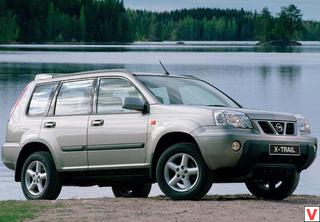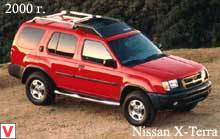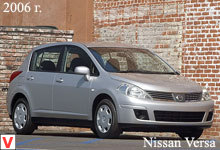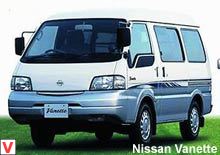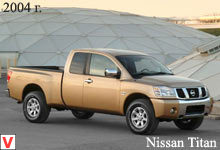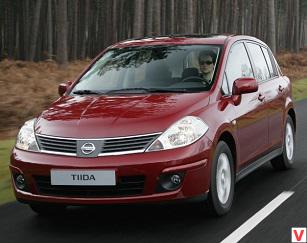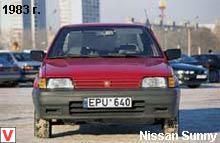
Nissan Terrano - off-road vehicle with a three-or five-door body. The first generation of compact SUV Nissan Terrano in the back of the WD21 debuted in August 1986. They collected it both in Japan and in America (under the name Nissan Pathfinder). Initially, only the three-door version was offered, and only in 1990 the five-door Terrano-I went on sale.
One of the distinguishing features of the first Terrano is that the length of the three- and five-doors is the same (2,650 mm), which is why the three-and five-door models are technically completely identical. The model with a three-door station wagon was partially unified with 1.0-ton Navara pickups with a four-and-a-half (King-size) and with a double six-seater cab. The usual pickup (with a wheel formula of 4x2 or 4x4) with a single three-seater cab differed in the shape of the front fenders and hood. In the five-door version of the rear door handles were very peculiarly camouflaged in the upper part of the rear pillars.
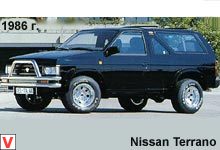
The design of the body and frame was designed with the requirements of passive safety. Five-seater all-wheel drive car on a powerful spar frame, characterized by high strength and good corrosion resistance, with a two-stage transfer case and locking rear differential fully meets modern concepts of SUVs. The front axle is connected with a lag, but it is equipped with disconnectable automatic clutches built into the hubs of the wheels, so the transition to the rear wheel drive “highway” state does not take much time and saves quite a lot of fuel.
The suspension has two levels of rigidity: sporty, when the body is less tilting in turns, and comfortable, when the long-stroke suspension doesn’t notice all the unevenness of the road surface. therefore, the transition to a rear-wheel-drive "highway" state does not take much time and allows you to save quite a lot of fuel. The suspension has two levels of rigidity: sporty, when the body is less tilting in turns, and comfortable, when the long-stroke suspension doesn’t notice all the unevenness of the road surface.
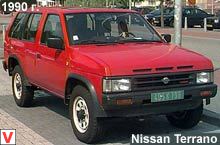
therefore, the transition to a rear-wheel-drive "highway" state does not take much time and allows you to save quite a lot of fuel. The suspension has two levels of rigidity: sporty, when the body is less tilting in turns, and comfortable, when the long-stroke suspension doesn’t notice all the unevenness of the road surface. Interior design is rustic, but quite ergonomic. The dashboard is in a rectangular style typical of the 'Japanese' of the mid-1980s, with a small casing over the middle part of the panel, combining transverse and longitudinal inclinometers and an altimeter completely useless on flat terrain.
All devices are clearly visible, and all levers (including the 'razdatkoy' control lever) are easily accessible. However, the driver’s landing, despite numerous adjustments, is far from optimal, since the pedals are too high and a tall driver simply has nowhere to go, and even adjusting the column helps a little. Ventilation of the cabin is also far from optimal. But the power steering is very easy, and the stability on the highway is quite sufficient for driving in any weather with high speed. Nevertheless, it is not worth overestimating the car’s capabilities in this regard, since the center of gravity is rather high due to the frame structure.
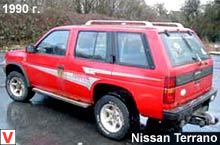
On the Nissan Terrano / Pathfinder, depending on the performance, they set both narrow and wide wheels, which greatly affects the handling. Trunk volume from 425 to 1550 liters is enough for the transport of bulky items. On the Terrano with injection engines, it is possible to self-diagnose all systems and injection sensors. This is very convenient in that you can make a qualified diagnosis to your car without any computers at service stations. A diagnostic unit is installed under the front passenger seat, on which all fault codes are displayed using two LEDs. It remains only to use a special table to determine which element or sensor is ill.
since the center of gravity due to the frame structure is quite high. On the Nissan Terrano / Pathfinder, depending on the performance, they set both narrow and wide wheels, which greatly affects the handling. Trunk volume from 425 to 1550 liters is enough for the transport of bulky items. On the Terrano with injection engines, it is possible to self-diagnose all systems and injection sensors.
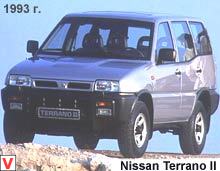
This is very convenient in that you can make a qualified diagnosis to your car without any computers at service stations. A diagnostic unit is installed under the front passenger seat, on which all fault codes are displayed using two LEDs. It remains only to use a special table to determine which element or sensor is ill.
since the center of gravity due to the frame structure is quite high. On the Nissan Terrano / Pathfinder, depending on the performance, they set both narrow and wide wheels, which greatly affects the handling. Trunk volume from 425 to 1550 liters is enough for the transport of bulky items. On the Terrano with injection engines, it is possible to self-diagnose all systems and injection sensors. This is very convenient in that you can make a qualified diagnosis to your car without any computers at service stations. A diagnostic unit is installed under the front passenger seat, on which all fault codes are displayed using two LEDs.
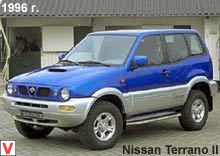
It remains only to use a special table to determine which element or sensor is ill. On the Nissan Terrano / Pathfinder, depending on the performance, they set both narrow and wide wheels, which greatly affects the handling. Trunk volume from 425 to 1550 liters is enough for the transport of bulky items. On the Terrano with injection engines, it is possible to self-diagnose all systems and injection sensors. This is very convenient in that you can make a qualified diagnosis to your car without any computers at service stations.
A diagnostic unit is installed under the front passenger seat, on which all fault codes are displayed using two LEDs. It remains only to use a special table to determine which element or sensor is ill. On the Nissan Terrano / Pathfinder, depending on the performance, they set both narrow and wide wheels, which greatly affects the handling. Trunk volume from 425 to 1550 liters is enough for the transport of bulky items. On the Terrano with injection engines, it is possible to self-diagnose all systems and injection sensors. This is very convenient in that you can make a qualified diagnosis to your car without any computers at service stations.
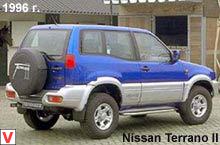
A diagnostic unit is installed under the front passenger seat, on which all fault codes are displayed using two LEDs. It remains only to use a special table to determine which element or sensor is ill. Trunk volume from 425 to 1550 liters is enough for the transport of bulky items. On the Terrano with injection engines, it is possible to self-diagnose all systems and injection sensors. This is very convenient in that you can make a qualified diagnosis to your car without any computers at service stations. A diagnostic unit is installed under the front passenger seat, on which all fault codes are displayed using two LEDs.
It remains only to use a special table to determine which element or sensor is ill. Trunk volume from 425 to 1550 liters is enough for the transport of bulky items. On the Terrano with injection engines, it is possible to self-diagnose all systems and injection sensors. This is very convenient in that you can make a qualified diagnosis to your car without any computers at service stations. A diagnostic unit is installed under the front passenger seat, on which all fault codes are displayed using two LEDs. It remains only to use a special table to determine which element or sensor is ill.
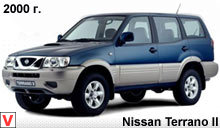
that you can make a qualified diagnosis of your car without any computers at the service stations. A diagnostic unit is installed under the front passenger seat, on which all fault codes are displayed using two LEDs. It remains only to use a special table to determine which element or sensor is ill. that you can make a qualified diagnosis of your car without any computers at the service stations. A diagnostic unit is installed under the front passenger seat, on which all fault codes are displayed using two LEDs. It remains only to use a special table to determine which element or sensor is ill.
At various times, since 1986, Nissan Terrano was completed with various engines. The Z24, a 2.4-liter gasoline 4-cylinder engine with a power of 103 hp, with a timing chain drive and two candles per cylinder, was produced from 1987 to 1992. Models with single injection went to the European market (while markets in third countries and in the United States met carburetor versions with a slightly modified ignition system). From the 88th year, the gasoline six-cylinder engine with a volume of 3.0 liters and a timing belt —VG30 — begins to be produced (which subsequently gained the most popularity).

The power of a single injection motor was 130 hp Distributed injection (from 1990) added another 18 hp to this figure. The TD27T turbocharger with a capacity of 2.7 liters and a power of 99 hp has become somewhat less common. This is a very reliable and modern engine, although it requires (like all diesel engines) high-quality and timely service. For the third country market and Japan, its non-turbo version of the TD27 was produced. Terrano is equipped with part-time four-wheel drive transmission. The main drive is rear, and if necessary the front axle is connected.
In most of the cars in the rear axle, there is a limited-slip differential - LSD, which, under heavy road conditions, slightly improves throughput. The transfer box is a two-stage, driven by a chain drive. Manual gearbox only 5-speed. Part of the cars was completed with a 4-speed automatic transmission. Fuel consumption in real urban use with a gasoline engine is about 16 l / 100 km. Dual-brake system with vacuum booster. Front ventilated disc brakes, but behind the possible options: either drum or ventilated disc (found infrequently). The efficiency and reliability of the entire brake system is high.
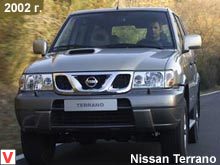
In 1993 he made his debut Terrano II. The new model is a joint development with Ford, created by the Nissan technology center in Barcelona (Spain), as well as its counterpart Ford Maverick. They belonged to the compact SUV class in the early 90s, only the Terrano II was designed for Europe. The design of the car was developed by the Belgian stylist Alain Blone. At first, a model with a short base (2450 mm) and a 3-door body (4105x1735x1800 mm) appeared on the market. Later, the 5-door version was extended to 2650 mm on the base with dimensions of 4585x1733x1810 mm.
The disadvantages of the Nissan Terrano 2 in the three-door version include a small trunk of only 425 liters and an uncomfortable fit in the back seat. The five-door station wagon of these minuses is deprived - the trunk has increased to 1,900 liters, and on some versions it installed a third row of seats. Model Terrano II with its tightly knit and at the same time neat design has a galvanized body. The traditional frame design provides it with high strength and body rigidity. The body is mounted on the chassis through rubber mounts that protect the cabin from shock and vibration.
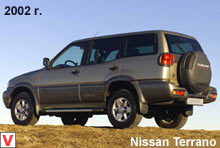
A high center of gravity leads to longitudinal rocking of the body at high speeds. This is especially felt on the short version. To reduce the buildup of the body during fast cornering, anti-roll bars are provided in the front and rear suspension.
Winter riding on the Terrano II does not bring trouble only when driving in 4x4 mode. On the rear wheel drive the car is extremely prone to drifts even on a completely flat and innocuous part of the snow-covered road. But it is necessary to connect the front axle, as everything falls into place. The Terrano II is a rather high car and it has its advantages: a spacious lounge with a high ceiling and a large glass area. Raised tailgate and spare tire on the tailgate significantly limit visibility when reversing, especially when parking. The interior is trimmed with sufficient quality, convenience and ergonomics at the height.
A good soundproofing of the cabin allows you to listen to music at speeds up to 130-140 km / h without straining. The basic equipment of these models is not rich: power steering, central locking, electric mirrors. However, the lack of leather and other electric drives is justified by the low price of a jeep.
The 1993-1995 Terrano II has only two versions of the inline 4-cylinder powertrain. The first one is a 2.7 liter turbo diesel with a capacity of 99 hp, and the second is a gasoline injection 12-valve engine with a volume of 2.4 liter and a power of 124 hp. Diesel is tighter and more economical, but with a gasoline unit the car is faster, although it has to spin up to 4.5-5 thousand revolutions.
Before the 1995 release of the Terrano II, an exclusively five-speed manual gearbox was installed. It is famous for its reliability and practically does not break. In July 1996, the car was upgraded. The design of the front end has changed (faded square headlights replaced the revolutionary and well-forgotten old round ones), and the bumpers of the modified shape began to be painted to match the body color. The 2.7-liter turbocharged diesel engine received intermediate air cooling and electronic fuel injection, thanks to which its capacity increased from 100 to 125 hp.
The 2.4-liter gasoline engine on the three-door version of the Terrano develops power of 116 hp, and on the longer five-door, 118 hp. In the serial equipment included airbag for the driver and an electronic anti-theft device. ABS as an option. In 1999 a new improved model was introduced in Frankfurt. The front of the body has become wider and more powerful thanks to the new grille and powerful bumper, which make Nissan Terrano c the flagship Nissan Patrol GR. Headlights with improved light indicators are collected in a single unit (the beam of the passing beam has become 40% wider, and its “range” has increased by 22%).
The rear part is lower and wider, equipped with new brake lights and a combination of rear lights. On the casing of the spare wheel hanging on the rear door, characteristic slots appeared to emphasize the stylistic unity of the front and rear parts of the car. The car has acquired a more aggressive and serious look. But the recognition of the Terrano II model provides a characteristic, with a smooth step, the rise of the lower boundary of the side windows. Because of this, the car seems taller and it seems that the rear passengers are very reliably protected by steel shells.
The so-called hydrophobic coating is now applied to the side windows of Terrano II, reducing the stain of contact with water droplets. Drops become smaller, and because of this, during rain, the glass remains quite transparent. At the heart of the power structure Terrano II - bearing frame. The suspension of the Terrano II is very short for an SUV and is therefore tightly adjusted, which, with the passage of serious irregularities (like a railway crossing), responds with a blow to the body.
New gas-filled shock absorbers appeared, which had a positive effect on comfort, and tires of the previous dimension 235/75 R15 gave way to a 16-inch: 235/70 R16. In the usual, "transport" mode, the Nissan Terrano II is a rear wheel drive car. If you pull the “dispensing” lever, the front axle will turn on (this operation is recommended at a speed of no more than 40 km / h).
Fully updated interior design. Slightly changed the center console. The new instrument panel is simple, the readings of the main devices are perceived perfectly, and minor details do not distract attention. A liquid crystal display located above the fuel and coolant sensors, in addition to being an odometer and clock, gives the driver information about the temperature behind. Picking got their own names: Elegance, Luxury, Sport and Comfort. Comfort - the most modest equipment, and Elegance - luxury equipment.
The installed equipment includes an audio system with six speakers. Since 1999, the Nissan Terrano II install and automatic transmission. As before, the model is offered either with a 116-horsepower four-cylinder petrol engine, or with a four-cylinder turbo diesel engine with a capacity of 125 liters.
from. In Europe, diesel Terrano II is more favored (besides, only diesel vehicles can be equipped with automatic gearboxes). The car Nissan Terrano II - the winner of the rally Grenada-Dakkar 1999 in the diesel class DI. Safety is achieved by improving braking performance. The ABS system is improved by installing non-blocking brakes designed specifically for off-road conditions. In addition to the four sensors on wheels, there is a special sensor that monitors the rate of deceleration on surfaces with high or low grip (ice or snow) and turns off at speeds below 8 km / h.
In addition to increasing the diameter of the rear brake discs, an electronic brake force distribution system (EBD, Electronic Brake Distribution) is now used on the Terrano II, which eventually reduced the stopping distance from 100 km / h by 8.2 m. In the spring of 2002, the next modernization of the Terrano II took place. The updated appearance and interior, a powerful 3.0-liter direct-injection turbo diesel engine, perfectly proven on the Nissan Patrol GR car, and the best in this class set of security tools make the Terrano an ideal multi-purpose off-road vehicle for families with active lifestyles. The updated look of the car emphasizes the aggressive nature of this SUV.
The main change in appearance is the new design of the hood with a clearly distinguished intercooling air intake, designed specifically for the larger 3.0-liter engine. This design emphasizes, on the one hand, the personality of the Terrano, and on the other hand, reflects the style of the entire class of Nissan SUVs. The grille is combined with block headlights, which creates an individual look of the car. The new 16-inch 6-spoke light-alloy wheels, combined with the practical hard spare wheel cover available in most trim levels, add even more individuality to the design of the new Terrano.
Significantly expanded colors - added four new options for painting the body. Updated interior - new door panels, a modified instrument panel and console, as well as an improved form of seats. Thanks to new materials, the appearance of the center console and instrument panel has been changed. The dashboard is made with the latest design developments, all control devices are located within 30 degrees from the line of sight of the driver, which makes it easy to keep them in sight.
The driver and front passenger will certainly appreciate the advantages of the new-shaped seats, the front airbag of which is increased by 25 mm in length and the frame of the seat backs is changed, which makes trips more comfortable. For greater comfort, the seats and the door in all trim levels from Sport to Elegance received high-strength upholstery materials. The high position of the driver's seat provides excellent visibility. All door switches are updated for maximum ease of use.
Another practical improvement appeared in the rear of the car - the luggage compartment now covers the easily removable shelf of fairly rigid material on which you can put a load weighing up to 5 kg. To reduce the penetration of ultraviolet rays inside the cabin on all the glass applied a special coating. It also helps to maintain coolness in the cabin, even in hot weather. In addition, to maintain the optimum temperature in the cabin, improved air conditioning system. Depending on the vehicle equipment, in addition to the 6-speaker audio system, a CD player can be located in the center console.
The latest version of the Nissan anti-theft system is combined with the anti-hijack system (the first time you press the button on the remote control door locks, only the driver’s door opens, and when you press it again, all other doors open). After the key is inserted into the ignition lock, the unique key and immobilizer codes are checked for their compliance, only after that the engine can be started. The emergence of a new engine capacity of 3.0 liters.
along with the existing 2.7 liter turbo diesel engine. and a 2.4 liter gasoline engine. significantly improves the position of Nissan in the class of all-wheel drive cars. The whole range of engines will be available for both 3-door and 5-door models. ZD30 is a new generation of engines with a direct injection system, gas distribution mechanism with two overhead camshafts and 16 valves. Such an engine design, combined with the use of the unique M-Fire fuel combustion technology (controlled combustion), allows to increase the economy and increase power. The suspension of the new Terrano is adapted to a 3.0 liter engine, taking into account off-road driving.
By improving transmission, mode selection can be made at any speed. To enhance the off-road performance, the Terrano is equipped with a limited slip differential, which provides movement even in the case of diagonal hanging. In addition to the already familiar active safety features such as ABS (anti-lock braking system) and EBD (electronic brake force distribution), for the first time in this class, the Terrano offers side-curtain airbags in combination with active head restraints to provide the highest level of safety for passengers. In case of impact, the head restraints move forward and up to reduce the risk of injury to the cervical vertebrae.
14-liter side airbags are standard on the Luxury and Elegance, and for the other sets are installed separately. Seat belts are equipped with pre-tensioners, which operate simultaneously with the front airbags. Together with the inertia reel belt pretensioner provides additional tightening of the seat belt webbing, holding the body of the driver or passenger in the event of a frontal impact. In April 2004, a restyled modification of the SUV appeared in Russia - 2004 Nissan Terrano II. The changes affected the appearance and interior of the car. Now put on the car 17-inch alloy wheels. Three new exterior colors have appeared (red Roma Red, green Tickford Green and gray Techno Gray).
New interior 2004 Nissan Terrano II is made in dark gray tones. In the Luxury version, the center console appeared “under the titanium”, and in the Elegance version, you can now order the trim of the seats with black perforated leather. In addition, folding versions for rear passengers are installed on both trim levels in the long-base versions.
Nissan Terrano 2014 - the most budgetary crossover in the Nissan lineup, and at the same time being a twin brother and co-platform Renault Duster. This model, although it bears the legendary name, under which in some countries sales of two generations of Nissan Pathfinder were carried out, in fact, is a completely independent model. For Russia, Terrano 2014 has been manufactured at Avtoframos enterprise since November 2013.
External dimensions of the body Terrano 2014 are: 4342 mm in length, 1822 mm (with rearview mirrors 2000 mm) in width, 1668 mm in height, with 2674 mm wheelbase and 205 mm (210 mm for all-wheel drive versions) ground clearance . Gross vehicle weight is 1726 kg. The crossover is shod in tires with the dimension of 215 / 65R16, depending on the level of configuration, steel or alloy wheels, a full-size spare tire, a 50-liter fuel tank, a washer tank designed for 5 liters of liquid, the steel crankcase protection is installed as standard.
The front of the Nissan Terrano 2014 is designed in the corporate style of a Japanese company with large blocks of headlights, a false grille with V-shaped inserts, a stylish and solid bumper with a wide air intake, classic round fog. The Terrano profile is characterized by powerful front and rear wheel arches, almost straight roof and window sill lines, and a large side glazing. In order to get a more contrasting design, the roof pillars are made in “radical black” color. The crossover feed received large headlamps of overall lighting, which were located not only on vertical racks, but also partially on the plane of the luggage compartment lid.
An updated bumper with a new arrangement of reflectors and a triangular plate for the plate, topped with a wide chrome plate complete the picture. The choice of enamel colors for body painting Terrano 2014 consists of six options: glacial white, gray, silver, beige, blue and black. The design of the Terrano 2014 saloon in terms of the architecture of the front panel, center console, door cards and the whole inner world repeats the decoration of the twin brother Renault Duster. But the interior of the Japanese crossover is more modern and solid than that of a French SUV with Romanian roots. Dashboard classic set - tachometer, speedometer, on-board computer screen.
On the vertical wall of the center console are located the audio, air conditioning and heating control units, just below (for all-wheel drive versions) the All-wheel-drive control system All Mode 4X4, on top of the dashboard there is a convenient box with a lid for storing small things. All controls are on hand and convenient to use, except, perhaps, the mirror adjustment unit, which is located under the handbrake lever. The salon is fully five-seater and allows you to comfortably accommodate the driver and passenger in the first row and three adult passengers on the second row sofa. The rear seatbacks fold in the 40/60 ratio.
The minimum amount of luggage - 475 liters in front-wheel drive versions and 408 liters in all-wheel drive. If you fold the rear row of seats, the net volume will increase, respectively, to the levels of 1636 and 1570 liters. Well, with the folded back of the front passenger seat, it will be possible to carry long lengths of up to 2.65 meters. Since the Terrano 2014 is built on the basis of the Renault Duster chassis, the suspension characteristics of both cars are the same, with the exception of certain settings made by the Japanese with the aim of improving the ride smoothness.
On the front, the Nissan Terrano is supported by a standard, independent design with MacPherson struts and an anti-roll bar. The rear part of the body rests on a semi-dependent torsion beam in versions with front-wheel drive and on a multi-link system with coil springs in versions with four-wheel drive. The 4WD system itself (All Mode 4 × 4) is based on a typical scheme for low-cost crossovers with an electromagnetic multi-plate clutch connecting the rear axle in case of front wheel slip. The brake system of the crossover includes front disc mechanisms and rear drum mechanisms.
The initial equipment Nissan Terrano Comfort has bumpers painted in body color, two front airbags, central locking with remote control, ABS + EBD, EBA system (emergency braking), as well as ESP (stabilization system), air conditioning, ISOFIX attachments for child seats, electric windows. front, 12V socket on the console, audio system with 4 speakers (MP3 / CD, Bluetooth, USB and AUX), adjustable steering column height, power steering, steel protection of the engine compartment.
The top Tekna version is complemented by side airbags, leather-trimmed seats and steering wheels, heated front seats, power windows for the rear doors, rear-view camera, rear parking sensors, Nissan Connect multimedia system with 5-inch color touchscreen, 16-inch light-alloy wheels, moldings and mirror housings, painted in the main body color, tinted rear windows, fog lights and roof rails. The motor range available in 2014 Nissan Terrano almost completely coincides with the line of Duster engines. The difference is only in the absence of a diesel engine, and two petrol units completely migrated from under the bonnet of the French.
As a base, customers will be offered a 4-cylinder engine with a displacement of 1.6 liters (1,598 cm3), which is equipped with fuel injection, a 16-valve DOHC type of timing belt and fully complies with the Euro-4 environmental standard. The maximum power of this motor is 102 hp, and the peak torque is at the mark of 145 Nm. The engine is aggregated with either a 5-speed "mechanics" in the versions with front-wheel drive, or with a 6-speed "mechanics" in all-wheel drive. In the first case, the crossover can dial the first 100 km / h on the speedometer in 11.8 seconds, or accelerate to 163 km / h of maximum speed.
In the second case, the dynamics will noticeably deteriorate: acceleration from 0 to 100 km / h will be 13.5 seconds, and the “maximum speed” will drop to 158 km / h. As for fuel consumption, the front-wheel-drive Nissan Terrano with the lower engine eats about 7.6 liters in the combined cycle, and all-wheel drive - 8.2 liters. The top engine for the crossover was also a 4-cylinder power unit, but with a working volume of 2.0 liters (1998 cm3). The engine fits into the framework of the Euro-4 standard, is equipped with a 16-valve DOHC timing belt, a system of distributed fuel injection and is capable of producing 135 hp. maximum power, as well as deliver up to 191 Nm of torque.
The front-wheel drive 2014 Nissan Terrano with this engine will receive a 4-band “automatic” as a gearbox, while all-wheel-drive modifications will be equipped with 6-speed “mechanics”. In the first case, the acceleration of the crossover from 0 to 100 km / h will take no more than 11.2 seconds, but the second one will completely fit in 10.4 seconds. The upper speed limit will be respectively 168 and 177 km / h.
